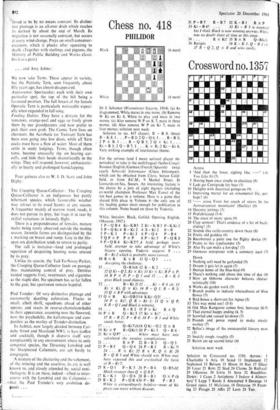Chess no. 418
PHILIDOR
Dr J. Schumer (Westminster Gazette, 1914). (a) As diagrammed, White mates in one move. (b) Remove W Kt on Kt 8, White to play and mate in two moves. (c) Also remove W P on K 7, mate in three moves. (d) Also remove W P on Kt 7, mate in four moves; solution next week.
Solution to no. 417 (Janet): R - B 8. threat R - K 8. 1 . . P - B 3; 2 Q - Q 6. 1 . . . B - B 3;
2 P x B. 1 . . . R - Q B 3; 2 Q x Kt. 1 . . . Kt - B 3; 2 Q - B 7. 1 . . K x R; 2 Kt - Kt 6. Very striking example of interference theme.
For the serious (and I mean serious) player the periodical to take is the multilingual (Serbo-Croat/ R ussian /English /German /French /Spanish) twice yearly Sahovski Informator (Chess Informant), which can be obtained from Chess, Sutton Cold- field, or from B.C.M., 9 Market Street, St Leonards-on-Sea, Sussex. An interesting feature is the choice by a jury of eight masters (including ex-world champion Professor Max Euwe) of the ten best games in a volume. Here is a game that shared fifth place in Volume 4—the only one of the leading games short enough for publication in this column. Notes based on those by Yudovic.
White. Smyslov. Black, Gufeld. Opening. English. (Moscow, 1967.) 1 P-Q B4 Kt-KB3 2 Kt-K B 3 P-KKt3
3 P - Q Kt 4 B - Kt 2 4 - Kt 2 0 - 0 5 P-K 3 P-Kt 3 6 P-Q4 P-B4
7 QP x P P xP 8 P-Kt 5 P-QR 3
9 P-QR 4 Kt-K5!? A bold, perhaps over- bold, attempt to take advantage of White's bizarre opening. Yudovic suggests 9 . . . B - Kt 2 which is probably more correct.
10 BxB KxB 11 Q-Q5 Accepting the challenge.
11 . . . Q-R4ch 12 K - K 2 .. .
12 Q Kt - Q 2, Kt X Kt; 13 Kt x Kt, R P x P:
14 B P X P, P - Q 3 and 15 . . . B - K 3 gives Black good chances.
12 . . . B - Kt 2! 12 . . . Kt - B 6 ch: 13 Kt x Kt. Q x Kt; 14 R- - Q I, R - R 2:
15 Q x BP with advantage.
13 Q x B Kt-QB3!l4 KKt-Q2! .
14 P x Kt?, Q R - Kt I: 15 Q X Q P, K R - Q I and Black is winning.
14 . . . R - R 2 15 P x Kt R x Q 16 P x R Q - Kt 5 17 Kt x Kt? . .
17 R - R 2!, P - B 4; 18 P - B 3 and White stands better.
17 . . Q-Kt7ch18 Q Kt -Q 2 Q x R 19 Kt x P R-QKt1 20 P- Kt 3 Q- R 6 21 Kt x Q P1 . . . White must have -mis- calculated the ensuing complkations.
21. . . R X P 22 B - R 3 Q - Q 3 23 P - B 5 Q - Q 4 24 P - B 3 R - Kt 7! 24 . . . R x Kt; 25 B x R, Q X B; 26 R - Q B I and White should win. White may have expected this and overlooked the force of R - Kt 7.
25 R -Q1 P-K 3 26 P - B 6 Q-B5ch! Much stronger than Q x Q B P.
27 K-K 1 Q-Q 6 28 B-B! QxPch
29 B-K 2 P-QR430 P-B4 P-B 3 White is extraordinarily helpless—none of his pieces can move without disaster. 31 P-B 7 R-B 7 32 K-B! R XP
33 Kt - B 4? . . 33 Kt - B 3 is essential but 1 think Black is now winning anyway. White was no doubt short of time at this stage.
34 . . . R x Kt! 35 B x R Q-B6ch 36 Resigns 36 K - K I. Q - B 3 di;
37 R- Q 2, Q X B and wins easily.


































 Previous page
Previous page